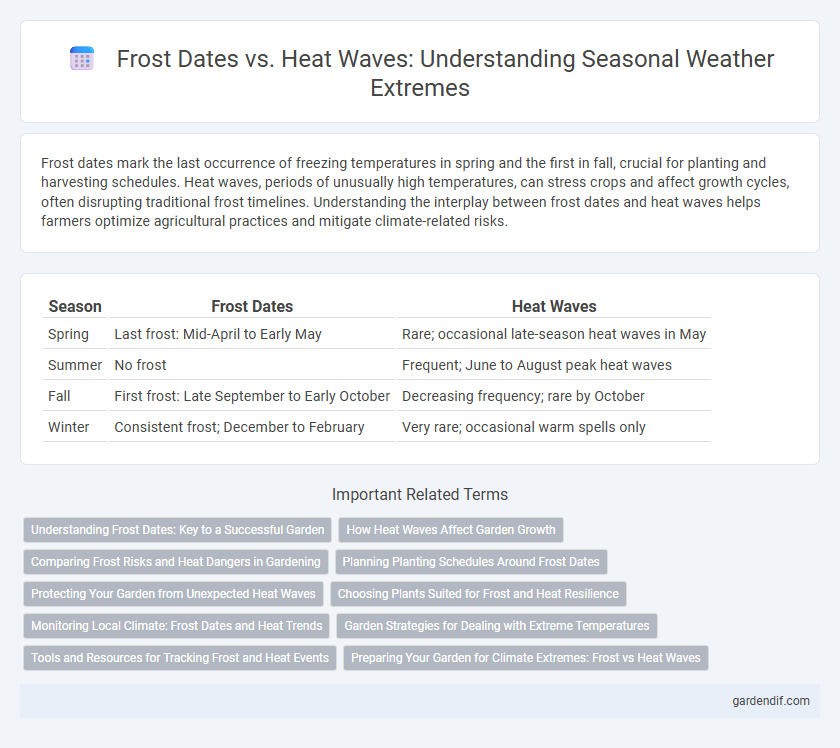
Frost dates vs Heat waves Illustration
Frost dates mark the last occurrence of freezing temperatures in spring and the first in fall, crucial for planting and harvesting schedules. Heat waves, periods of unusually high temperatures, can stress crops and affect growth cycles, often disrupting traditional frost timelines. Understanding the interplay between frost dates and heat waves helps farmers optimize agricultural practices and mitigate climate-related risks.
Table of Comparison
| Season | Frost Dates | Heat Waves |
|---|---|---|
| Spring | Last frost: Mid-April to Early May | Rare; occasional late-season heat waves in May |
| Summer | No frost | Frequent; June to August peak heat waves |
| Fall | First frost: Late September to Early October | Decreasing frequency; rare by October |
| Winter | Consistent frost; December to February | Very rare; occasional warm spells only |
Understanding Frost Dates: Key to a Successful Garden
Frost dates mark the critical periods when temperatures drop low enough to damage sensitive plants, typically occurring in early spring and late fall. Knowing your region's average last spring frost and first fall frost dates allows gardeners to schedule planting and harvesting, avoiding crop loss. Heat waves, often following these frost windows, stress plants by causing rapid moisture loss and can be mitigated by timely irrigation and shading strategies.
How Heat Waves Affect Garden Growth
Heat waves accelerate plant metabolism, often causing increased water demand and stress, leading to wilting and reduced growth in gardens. Unlike frost dates that signal cold damage risk and dormancy periods, heat waves impose heat stress that can stunt development and delay flowering. Maintaining adequate irrigation and shade during prolonged high temperatures is crucial to sustaining healthy garden growth during heat waves.
Comparing Frost Risks and Heat Dangers in Gardening
Frost dates mark the risk periods when temperatures drop below freezing, damaging sensitive plants and delaying growth cycles in gardening. Heat waves pose a contrasting danger by causing heat stress, dehydration, and accelerated evaporation, which harm plant health and reduce yields. Understanding local frost dates alongside heat wave patterns enables gardeners to optimize planting schedules and implement protective measures for both cold and heat-related stress.
Planning Planting Schedules Around Frost Dates
Understanding local frost dates is essential for planning planting schedules to avoid crop damage and maximize growth potential. Frost dates mark the last expected spring frost and first autumn frost, guiding gardeners to select frost-tolerant varieties or use protective measures during vulnerable periods. Heat waves following frost dates require careful timing to ensure seedlings have established roots, preventing stress and promoting healthy development.
Protecting Your Garden from Unexpected Heat Waves
Frost dates mark the safe planting window for many crops, but unexpected heat waves can stress plants beyond their tolerance levels, causing wilting and sunburn. Understanding regional frost date averages and monitoring weather forecasts allows gardeners to implement protective measures such as shade cloths, mulching, and increased watering to mitigate heat stress. Timely responses to heat waves safeguard plant health, preserve yield, and maintain garden vitality amid shifting seasonal patterns.
Choosing Plants Suited for Frost and Heat Resilience
Selecting plants with proven frost tolerance and heat resilience ensures survival through unpredictable seasonal extremes, especially in regions where late frost dates and early heat waves overlap. Frost-hardy perennials like hellebores and heat-tolerant species such as lavender thrive when matched to local climate patterns, reducing risks of damage and promoting consistent growth. Prioritizing native or well-adapted cultivars further enhances plant performance by leveraging natural resistance to temperature fluctuations inherent to the zone's frost and heat timelines.
Monitoring Local Climate: Frost Dates and Heat Trends
Monitoring local climate trends involves analyzing frost dates and heat waves to understand seasonal patterns and agricultural impacts. Accurate data on first and last frost dates combined with temperature spikes during heat waves helps predict crop vulnerability and optimize planting schedules. Climate monitoring tools integrate historical frost records and real-time heat trends, enabling proactive responses to weather extremes in seasonal agriculture.
Garden Strategies for Dealing with Extreme Temperatures
Frost dates signal critical planting deadlines to avoid damage from sudden cold snaps, guiding gardeners to choose hardy crops or use protective coverings like row covers and cloches. Heat waves demand strategies such as mulching to retain soil moisture, strategic shading through shade cloths or tall companion plants, and increased irrigation schedules to prevent heat stress. Combining frost date awareness with heat wave preparedness enhances garden resilience against temperature extremes.
Tools and Resources for Tracking Frost and Heat Events
Precise tools for tracking frost dates and heat waves include agricultural frost prediction models, NOAA's Climate Prediction Center resources, and localized weather station data. Mobile apps such as Frost Finder and Heat Alert provide real-time monitoring and alerts tailored for farming and gardening activities. Integrating these resources enhances preparedness and minimizes crop damage during critical seasonal temperature fluctuations.
Preparing Your Garden for Climate Extremes: Frost vs Heat Waves
Frost dates mark the last expected freeze in spring and the first in fall, crucial for timing planting and protecting sensitive plants from cold damage. Heat waves, characterized by prolonged high temperatures, stress plants by increasing water loss and accelerating growth cycles, requiring efficient irrigation and mulching strategies. Preparing your garden involves monitoring local frost dates and heat wave forecasts to implement timely frost protection measures like covers and shade structures, ensuring plant resilience against climate extremes.
Frost dates vs Heat waves Infographic

 gardendif.com
gardendif.com